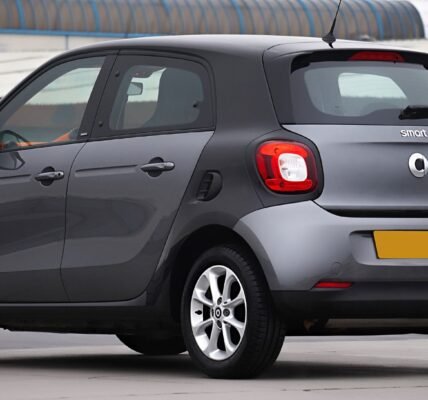The world of automobiles is changing fast. With a push toward sustainability, solar-powered cars are emerging as a potential solution to reduce reliance on fossil fuels. While electric vehicles (EVs) are gaining popularity, solar cars take green transportation a step further by using the sun as a power source. But, how viable are solar-powered cars for the future? Let’s explore the concept and see if solar-powered cars’ future is truly as bright as we hope.
What Are Solar-Powered Cars?
A solar-powered car is a vehicle that uses solar panels to convert sunlight into electricity. This energy powers the vehicle’s electric motor, reducing or eliminating the need for conventional fuel. Solar panels, often installed on the roof or body of the car, capture the sun’s energy and store it in batteries for use.
- How It Works
Solar-powered cars harness energy from the sun using photovoltaic (PV) cells. These cells convert sunlight into electricity. The energy is then stored in a battery, which powers the vehicle’s electric motor. This process makes solar cars’ future a promising prospect, as it reduces emissions and fossil fuel consumption. - Benefits of Solar-Powered Cars
Solar cars offer several advantages over traditional gas-powered vehicles. First, they produce zero emissions, making them an eco-friendly alternative. Additionally, using solar energy reduces the cost of driving, as sunlight is free and abundant. These factors contribute to solar-powered cars’ future looking increasingly promising.
Solar-Powered Cars vs. Electric Vehicles
While EVs are becoming the norm for sustainable transportation, solar-powered cars take a unique approach. EVs rely on electricity from charging stations, often sourced from the grid. However, solar cars use renewable energy directly from the sun, making them more self-sufficient.
- Energy Independence
Solar-powered cars provide energy independence since they generate their own electricity. This reduces the need for external charging infrastructure, which can be costly and limited in some regions. As the solar-powered cars’ future unfolds, their ability to operate without relying on traditional power grids may become a key selling point. - Charging Convenience
One of the biggest challenges for EV owners is finding charging stations. Solar-powered cars solve this issue by generating their own energy. Although solar cars still require batteries, having onboard solar panels can help extend their range and reduce the need for frequent charging stops. This convenience makes solar cars’ future more appealing for everyday drivers. - Environmental Impact
Both solar-powered cars and EVs offer environmental benefits. However, solar cars take sustainability a step further. EVs rely on electricity that may still come from fossil fuel sources. In contrast, solar-powered cars harness clean, renewable energy. This makes solar-powered cars’ future even greener.
Current Challenges Facing Solar-Powered Cars
While solar-powered cars’ future holds potential, there are challenges to overcome before they become mainstream. Solar technology is still evolving, and there are limitations to how much energy current PV cells can generate. Here are some challenges:
- Energy Efficiency
One of the main obstacles is the efficiency of solar panels. Current solar panels can only convert a small percentage of sunlight into usable energy. This means that solar-powered cars may not generate enough power to run for long distances or high speeds. Improving solar panel efficiency will be critical to solar-powered cars’ future success. - Weather Dependency
Solar-powered cars rely on sunny conditions to generate electricity. In regions with less sunlight, or during cloudy or rainy days, solar-powered cars may struggle to produce enough energy. This weather dependency is a hurdle for the solar cars’ future, especially in areas with unpredictable climates. - Battery Storage
Storing solar energy for later use is another challenge. Solar-powered cars need efficient battery systems to store excess energy generated during sunny conditions. However, battery technology is still developing, and improving energy storage capacity is key to unlocking solar-powered cars’ future potential.
Innovations Driving Solar-Powered Cars
Despite the challenges, the solar-powered cars’ future looks bright thanks to ongoing innovations in the field. Researchers and automakers are working to improve solar panel efficiency, battery storage, and overall vehicle design. Let’s look at some exciting innovations that are shaping the future of solar-powered vehicles.
- Lighter Vehicle Designs
To maximize the efficiency of solar-powered cars, manufacturers are creating lightweight designs. Lighter cars require less energy to move, making them more compatible with the limited energy generated by solar panels. By reducing weight, solar-powered cars’ future becomes more feasible for mass production. - High-Efficiency Solar Panels
Advances in solar technology are improving the efficiency of photovoltaic cells. Researchers are developing solar panels that can capture more sunlight and convert it into electricity at a higher rate. These advancements will play a crucial role in solar-powered cars’ future by making them more energy-efficient. - Integrated Solar Roofs
Some automakers are experimenting with integrated solar roofs, where the entire car roof is a solar panel. This design maximizes the surface area for capturing sunlight, leading to more energy generation. The solar cars’ future may see more of these sleek, energy-efficient designs on the road.
Will Solar-Powered Cars Replace Traditional Vehicles?
The question remains: will solar-powered cars replace traditional gas-powered or even electric vehicles? The answer lies in the continued development of solar technology and how it integrates with existing transportation infrastructure.
- Long-Term Potential
In the long term, solar-powered cars’ future could see them replacing traditional vehicles, especially in regions with abundant sunlight. Their ability to generate their own energy offers a unique advantage in reducing reliance on fossil fuels. However, for now, they may serve as a complement to electric vehicles, providing a green alternative for short commutes or urban driving. - The Role of Solar in Sustainable Transportation
Solar-powered cars represent a significant step toward sustainable transportation. While they may not fully replace traditional cars soon, their presence will undoubtedly grow. As we move toward a greener future, solar-powered cars’ future will likely play a role in reducing carbon emissions and fostering renewable energy use.
Key Trends to Watch
As the solar-powered cars’ future unfolds, here are some trends to keep an eye on:
- Government Incentives
Governments may introduce incentives for adopting solar-powered vehicles. Tax credits, rebates, or grants could encourage consumers to switch to solar-powered cars, speeding up their adoption and making solar-powered cars’ future more promising. - Collaboration with the Electric Vehicle Industry
Solar-powered cars may work in conjunction with electric vehicles. For instance, some electric cars already feature solar panels to extend their range. This hybrid approach could pave the way for solar-powered cars’ future by integrating solar technology with existing EV infrastructure. - Energy Storage Solutions
Advances in battery storage technology will be essential for the solar-powered cars’ future. As more efficient batteries become available, solar cars will store more energy and offer longer driving ranges, making them more practical for everyday use.
Conclusion: The Future Looks Bright
The potential of solar-powered cars is undeniable. As technology advances, the dream of solar-powered transportation comes closer to reality. While challenges remain, the progress being made in solar panel efficiency, vehicle design, and battery storage is paving the way.





